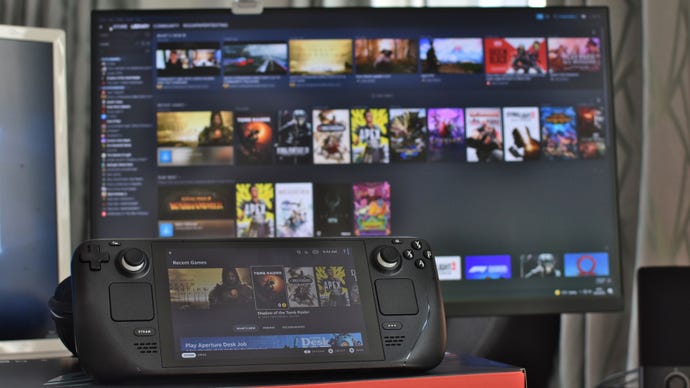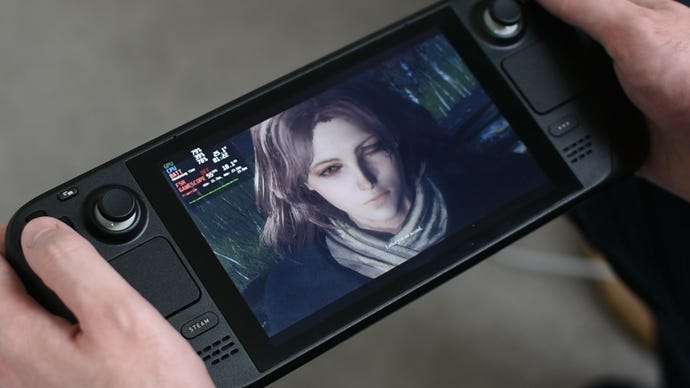"The community continues to blow our minds": Valve talk the Steam Deck, one year on
The portable PC’s creators reflect on its first anniversary and look to its future
Happy birthday, anniversary, launchiversary, or whatever you want to call it to the Steam Deck. Valve’s handheld SteamOS games machine has successfully evaded hardware flop status, currently sitting fourth in Steam’s own top sellers list a full year after it began shipping. That’s well deserved, too: the Steam Deck was a fun little alternative way to play PC games when it released, and through a combination of added features, ongoing improvements to game compatibility, and simply a wider choice of great games, it’s a better device now than it’s ever been.
I was originally going to look back on the Steam Deck’s first 12 months with my eyes only, but what fun is a party of one? Thus I invited Valve designer Lawrence Yang and engineer Pierre-Loup Griffais for their takes on the Deck’s past, present, and future.
"It's been great to see", says Griffais of the Steam Deck’s Year One reception. "The most surprising thing to me has been the variety of use cases we've seen. We certainly intended for the Deck to be flexible and let you play how you want, but what we've seen come out of the community continues to blow our minds."
Yang agrees, and offers a surprising stat on just how deep the handheld has taken root. "Internally, we've loved using Steam Deck through all of its prototype stages, and it's been amazing to see customers in the wild having just as much fun now that we've shipped", he says. "The biggest surprise for me has been seeing how Steam Deck has changed the way people are playing their games. One thing we've learned recently is that of the people who've purchased a Steam Deck, 42% of them end up spending the majority of their Steam gaming time on Steam Deck – preferring it over their other devices."
Clearly, then, the Steam Deck hasn’t struggled to find an audience, in spite of the initially long waits between making a reservation order and actually receiving it. That delay is now down to 1-2 weeks, no reservation required, and as Griffais says, there’s considerably more versatility in how you can use your new toy than there was at launch.
Not just in the sense of whether to play it on the sofa or on the commute, or whether you stick purely to handheld use or try setting it up as a desktop PC. The past 12 months have brought an armoury of peripherals, from Valve’s own dock to some offbeat third-part addons, that can tweak how you deploy the controls or view the display. Emulators are up and running, for consoles spanning from the Mega Drive to the Nintendo Switch. Some artistic souls are crafting beautiful/funny/ironic custom boot videos. And just today, someone on the Steam Deck subreddit shared a script that automatically uploads Steam Deck screenshots to a separate PC. I’ve been wanting something like that for months!
Many of these developments are, evidently, community-driven. Though some have been enabled by Valve’s practice of developing and adding entire new features to the Steam Deck via software updates, a key factor in why it’s a better device now than it was last year. Some of these have been small – a new lock screen here, an overheating warning there – while others can have marked effects on the Deck’s performance and battery life, like the more in-depth refresh rate settings rolled out in May 2022. Despite the frequency of feature updates, however, Valve don’t see any additions in particular as standout game-changers.
"Given that everyone has their own usage style, it's been hard to pinpoint any specific improvement as the most impactful", says Griffais. "I think all the things you mentioned are instrumental for a cross-section of users, and we intend to keep adding major features going forward."
"A significant portion of the feedback we see is in line with things that we're already working on"
"One thing we've focused on with these updates", adds Yang, "is to try to add functionality and update features in a way that make the Steam ecosystem better as a whole. The best example of this is the controller-first UI we created for Steam Deck now becoming the updated Big Picture experience for all of Steam, regardless of device."
Like Griffais says, there’s more to come too. Doom Eternal recently gained ray tracing support on the Deck, possibly paving the way for other ray tracing-capable games to show off their best reflections, lighting and shadows on the handheld. Valve have other ideas that they’re keeping quiet about, though according to Griffais, they may align with requests from the wider Steam Deck-owning public.
"Taking feedback is by far the main tool we apply to evaluate success and determine next steps", he explains. "That being said, as PC gamers and Deck users ourselves, we've had a long time to think about what we wanted out of it prior to release, and a significant portion of the feedback we see is in line with things that we're already working on, or were planning to work on. We're just going down the list as quickly as development bandwidth allows."

Another concern vying for Valve’s attention is game compatibility. To be sure, this has improved significantly over the last year: incompatibility issues with certain anti-cheat systems or media codecs often left swathes of games unplayable, but these have since been largely fixed. "I'd say we don't have many big compatibility holes remaining", Griffais asserts, and development focus has shifted more towards what he calls "value-add features" like HDR. And, indeed, ray tracing.
But work does continue, especially on Proton, the compatibility layer that lets most games developed for Windows run on the Linux-based SteamOS to begin with. Griffais credits "fruitful" relationships between Valve and other game developers that allow the former time to look over a lot of PC games before they’re released, sometimes even apparently leading to the ID’ing and fixing of technical problems that would have affected native Windows and console versions as well. It’s still a process designed to benefit the Steam Deck, of course, and often it’s produced some majorly impactful Proton and SteamOS updates. Think the patch that smoothed out some of Elden Ring’s stuttering, or fixed Final Fantasy XIV – the latter a personal favourite of Valve co-founder Gabe Newell himself.
The dark side of all this is the that yes, the Steam Deck can still have compatibility problems, and not just with new releases. But at least Valve are attentive to them, sometimes fixing a problem within hours of the game’s launch. Or even before: the SteamOS update that enabled Doom Eternal’s ray tracing also contained urgent fixes for Wo Long: Fallen Dynasty, which wouldn’t release until the day after the update.

The Steam Deck Verified program is still going strong, too. Far from slowing it down, Yang says Valve have "evolved" the process since launch, with over 10000 Steam games having been rated for their compatibility with the Deck. Over 8000 of those have earned the desirable Playable or Verified status, up 1000 from the end of 2022. Not a bad pace at all.
"A true next-gen Deck with a significant bump in horsepower wouldn’t be for a few years"
Unfortunately, it’s not always just Linux/Proton incompatibility hiccups that can limit a game on the Steam Deck. System requirements for major games are on the up, and while the Deck impressed at launch for its ability to run even demanding games at 30fps or higher, more recent releases (like Wild Hearts and Returnal) are now proving simply too much for the hardware even on their lowest settings. Are Valve confident that the Deck’s muscle will remain strong enough in the near future, as big-budget games become hungier and hungrier for high-end components?
"It's hard to say as it'll depend on how developers approach it", Griffais says. "I believe the Deck has the potential to be a solid target throughout the generation, but the work involved is trickier than the typical Deck UX tweaks that developers have had to do for games that already perform well."
"That said, there are benefits to game developers doing this work. If high-end current-gen titles are able to scale to Deck and be a great experience, it also enables smoother performance on a wider variety of PCs, and improve the experience for the whole playerbase."
"We're optimistic about this, though", Yang adds, citing other recent games that do run fine. "We've seen a number of recently released demanding titles perform well on Steam Deck, due to developers targeting and testing on the device. We've also seen a very positive response from customers when titles are Deck Verified or Playable, which has been great to see."
It’s true that the prettied-up likes of Atomic Heart and the Dead Space remake can run on the Steam Deck with the right settings, and even the famously demanding Cyberpunk 2077 recently won Verified status. It is a shame that not everything else will, though again, the overall compatibility situation is far more favourable now than it was a year ago.
What’s more, the Steam Deck’s first year in the wild has shown it really is much more of a PC than a console. It hasn’t been simply released and left to do its job as a shifter of more profitable software – it’s been repeatedly, almost constantly updated and improved, with plenty of opportunities for customisation and personalisation emerging though its own users as much as its creators. Would it benefit from more development help in the future? Sure, but there’s no question of it receiving that, whether or not it comes with a focus shift from 'things the Steam Deck can do' to a more specific 'things games can do on a Steam Deck', like HDR and ray tracing.

Either way, it’s had an auspicious 12 months by any reasonable metric, and just in case you were wondering, it isn’t in danger of getting dumped and replaced by a new model either. While the Steam Deck’s success has "has made us even more excited to look closely at what can be improved", according to Yang, he reckons "a true next-gen Deck with a significant bump in horsepower wouldn’t be for a few years."
So, regular old, first-gen, one and only Steam Deck: see you here again in 2024. And happy birthday.









